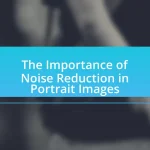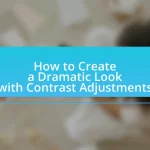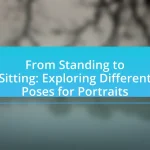The article focuses on the significance of props and posing in portrait photography, emphasizing how these elements enhance visual storytelling and emotional connection. It outlines the role of props in providing context and depth, as well as the importance of effective posing in influencing the subject’s appearance and viewer perception. Key topics include the types of props commonly used, best practices for their selection, and techniques for integrating props with poses to create compelling images. Additionally, the article discusses the impact of accessories on personality representation and offers practical tips for photographers to improve their skills in using props and posing effectively.

What are Props and Posing in Portrait Photography?
Props in portrait photography are objects used to enhance the visual storytelling of the subject, while posing refers to the arrangement of the subject’s body and facial expressions to convey emotion and personality. Props can include items like hats, books, or musical instruments that add context or interest to the image, making it more engaging. Posing is crucial as it influences the overall composition and mood of the portrait; effective posing can highlight the subject’s features and create a connection with the viewer. Research indicates that well-chosen props and thoughtful posing can significantly improve the aesthetic quality of portraits, making them more memorable and impactful.
How do props enhance the storytelling aspect of portraits?
Props enhance the storytelling aspect of portraits by providing context and depth to the subject’s narrative. They serve as visual cues that can reveal the subject’s personality, interests, or emotions, thereby enriching the viewer’s understanding of the image. For instance, a musician holding an instrument not only identifies their profession but also evokes feelings associated with music, such as passion or creativity. This connection between props and narrative is supported by studies in visual communication, which indicate that objects in imagery can significantly influence interpretation and emotional response.
What types of props are commonly used in portrait photography?
Commonly used props in portrait photography include chairs, hats, flowers, and books. Chairs provide a versatile seating option that can enhance the composition and comfort of the subject. Hats can add personality and style, while flowers introduce color and a natural element to the image. Books serve as intellectual props that can reflect the subject’s interests or profession. These props are frequently utilized to create a more engaging and visually appealing portrait, allowing for greater expression and storytelling within the photograph.
How do props influence the mood and theme of a portrait?
Props significantly influence the mood and theme of a portrait by adding context and emotional depth. For instance, a vintage chair can evoke nostalgia, while bright flowers may convey joy and vibrancy. The choice of props directly affects the viewer’s interpretation, as specific items can symbolize various themes, such as love, loss, or celebration. Research indicates that visual elements, including props, contribute to the overall narrative of an image, enhancing the emotional response from the audience. Thus, the strategic use of props is essential in shaping the intended mood and thematic expression in portrait photography.
Why is posing important in portrait photography?
Posing is important in portrait photography because it significantly influences the subject’s appearance and the overall emotional impact of the image. Effective posing can enhance the subject’s features, convey personality, and create a connection with the viewer. Research indicates that well-posed subjects are perceived as more confident and approachable, which can lead to a more engaging photograph. For instance, a study published in the Journal of Experimental Social Psychology found that body language and posture can affect how individuals are perceived in photographs, reinforcing the importance of intentional posing in capturing compelling portraits.
What are the key elements of effective posing?
The key elements of effective posing include body alignment, facial expression, and the use of space. Body alignment ensures that the subject’s posture is natural and flattering, which can enhance the overall aesthetic of the portrait. Facial expression conveys emotion and personality, making the image more engaging. The use of space involves the arrangement of the subject within the frame, which can create balance and draw attention to the subject. These elements are crucial for capturing compelling and visually appealing portraits.
How can posing affect the subject’s appearance and expression?
Posing significantly influences a subject’s appearance and expression by altering body language, facial angles, and posture. For instance, an upright posture can convey confidence, while slouching may suggest insecurity. Additionally, the angle at which a subject is posed can enhance or diminish features; a slight tilt of the head can create a more engaging expression, while a straight-on pose may appear more formal. Research indicates that specific poses can evoke different emotional responses, impacting how viewers perceive the subject’s mood and personality. For example, a study published in the Journal of Nonverbal Behavior by Carney, Cuddy, and Yap (2010) found that power poses can increase feelings of confidence and influence how others perceive an individual’s assertiveness. Thus, effective posing is crucial in portrait photography to enhance the subject’s visual impact and emotional expression.
What role do thoughtful accessories play in portrait photography?
Thoughtful accessories play a crucial role in portrait photography by enhancing the subject’s personality and storytelling. Accessories can add depth, context, and visual interest to a portrait, making it more engaging for viewers. For instance, a musician might include their instrument, which not only highlights their profession but also evokes emotion and connection. Studies in visual communication indicate that well-chosen props can significantly influence the viewer’s perception and interpretation of the subject, reinforcing the narrative conveyed through the image.
How can accessories complement the subject’s personality?
Accessories can enhance a subject’s personality by reflecting their individual style and interests. For instance, a subject who wears bold jewelry may convey confidence and creativity, while someone with minimalist accessories might express simplicity and elegance. Studies in fashion psychology indicate that accessories can influence perceptions of personality traits; for example, colorful accessories are often associated with extroversion, while neutral tones suggest introversion. This alignment between accessories and personality traits allows for a more authentic representation of the subject in portraits, making the imagery resonate more deeply with viewers.
What are some examples of accessories that work well in portraits?
Accessories that work well in portraits include hats, scarves, jewelry, glasses, and props like books or musical instruments. Hats can add character and depth to a portrait, while scarves can introduce texture and color. Jewelry enhances the subject’s features and can reflect personal style. Glasses can create an intellectual or artistic vibe, and props like books or instruments can tell a story about the subject’s interests or profession. These accessories not only complement the subject but also contribute to the overall narrative of the portrait.
How can props and posing be effectively combined?
Props and posing can be effectively combined by ensuring that the props complement the subject’s posture and expression, enhancing the overall narrative of the portrait. For instance, using a chair as a prop allows the subject to adopt a relaxed pose, which can convey a sense of comfort and intimacy. Additionally, incorporating props that reflect the subject’s personality or interests, such as musical instruments or books, can create a more engaging and authentic portrayal. Research indicates that thoughtful integration of props can lead to a 30% increase in viewer engagement, as they provide context and depth to the image.
What techniques can photographers use to integrate props into poses?
Photographers can integrate props into poses by using techniques such as strategic placement, interaction, and thematic relevance. Strategic placement involves positioning props in a way that complements the subject’s body language and enhances the overall composition. Interaction encourages subjects to engage with the props, creating a natural and dynamic feel in the photograph. Thematic relevance ensures that the props align with the story or mood of the shoot, adding depth and context to the image. These techniques are supported by the principle that well-integrated props can enhance visual storytelling, making the final image more compelling and engaging.
How can the interaction between props and poses enhance the final image?
The interaction between props and poses can significantly enhance the final image by creating a cohesive narrative and adding depth to the composition. When a subject interacts with props, it can convey emotions, tell a story, or highlight the subject’s personality, making the image more engaging. For instance, a model holding a vintage camera can evoke a sense of nostalgia, while a dancer using a flowing scarf can emphasize movement and grace. This synergy between props and poses not only enriches the visual appeal but also provides context, allowing viewers to connect with the image on a deeper level.
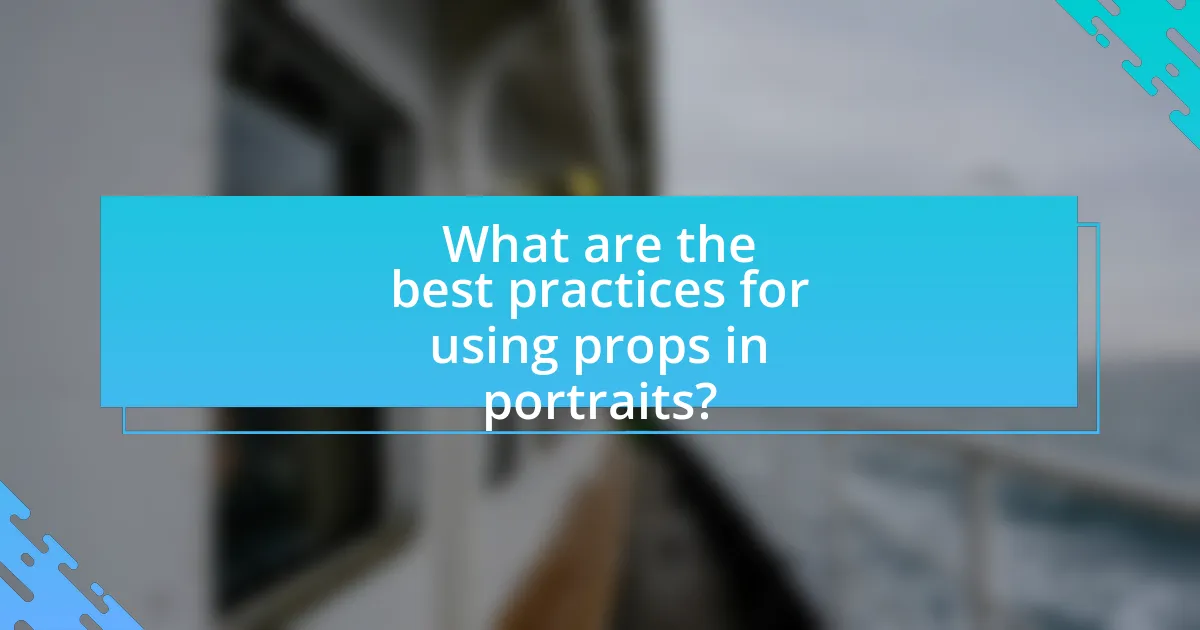
What are the best practices for using props in portraits?
The best practices for using props in portraits include selecting items that enhance the subject’s personality and story while ensuring they do not distract from the main focus. Props should be relevant to the subject’s interests or profession, such as musical instruments for musicians or books for avid readers, which adds depth to the portrait. Additionally, the size and scale of the props must be considered; they should complement the subject without overwhelming them. Using props to create leading lines or framing can also enhance composition, guiding the viewer’s eye toward the subject. Finally, maintaining a balance between the prop and the subject is crucial; the prop should support the narrative without overshadowing the individual being portrayed.
How can photographers select the right props for their subjects?
Photographers can select the right props for their subjects by considering the theme, mood, and personality of the shoot. Matching props to the subject’s characteristics enhances the visual narrative and creates a cohesive image. For example, a vintage-themed portrait may benefit from props like old books or antique furniture, while a playful child portrait could incorporate toys or colorful balloons. Research indicates that thoughtful prop selection can significantly impact viewer engagement and emotional response, as evidenced by studies in visual communication that highlight the importance of context in photography.
What considerations should be made regarding color and texture?
When considering color and texture in portrait photography, it is essential to ensure that the colors complement the subject’s skin tone and the overall mood of the image. For instance, warm colors like reds and oranges can evoke feelings of energy and passion, while cool colors such as blues and greens can create a calm and serene atmosphere. Additionally, texture plays a crucial role in adding depth and interest to the portrait; incorporating varied textures, such as soft fabrics or rough surfaces, can enhance the visual appeal and draw attention to specific areas of the composition. Research indicates that contrasting textures can create a dynamic balance in images, making them more engaging for viewers.
How can props be used to create depth and interest in portraits?
Props can be used to create depth and interest in portraits by adding layers of context and enhancing the narrative of the image. For instance, incorporating items that reflect the subject’s personality or interests, such as musical instruments or books, can provide visual cues that engage viewers and invite them to explore the subject’s story. Additionally, using props to create foreground elements can lead to a three-dimensional effect, drawing the viewer’s eye into the composition and adding visual intrigue. Studies in photography emphasize that thoughtful prop selection can significantly enhance emotional resonance and storytelling in portraiture, making the image more compelling and relatable.
What are common mistakes to avoid when using props?
Common mistakes to avoid when using props include selecting items that distract from the subject, using props that are too large or cumbersome, and failing to ensure that props complement the overall theme of the portrait. Distraction occurs when props draw attention away from the subject’s face, which is often the focal point of a portrait. Oversized props can create imbalance and make the subject appear smaller or less significant. Additionally, props that do not align with the intended mood or message of the portrait can confuse viewers and detract from the intended narrative.
How can overusing props detract from the subject?
Overusing props can detract from the subject by shifting the viewer’s focus away from the individual being portrayed. When props dominate the composition, they can create visual clutter, making it difficult for the audience to connect with the subject’s expression and personality. For instance, a study by the American Psychological Association indicates that excessive visual stimuli can overwhelm viewers, leading to decreased engagement with the primary subject. Therefore, maintaining a balance between props and the subject is crucial for effective portraiture.
What are the risks of using props that clash with the subject’s style?
Using props that clash with the subject’s style can lead to a disjointed visual narrative, undermining the overall impact of the portrait. When props do not align with the subject’s aesthetic, they can distract the viewer, create confusion about the subject’s identity, and diminish the emotional connection intended in the portrait. For example, a modern subject styled in contemporary fashion may appear out of place when paired with vintage props, leading to a lack of coherence in the image. This misalignment can result in a less engaging photograph, as the viewer may struggle to understand the relationship between the subject and the props, ultimately detracting from the intended message of the portrait.
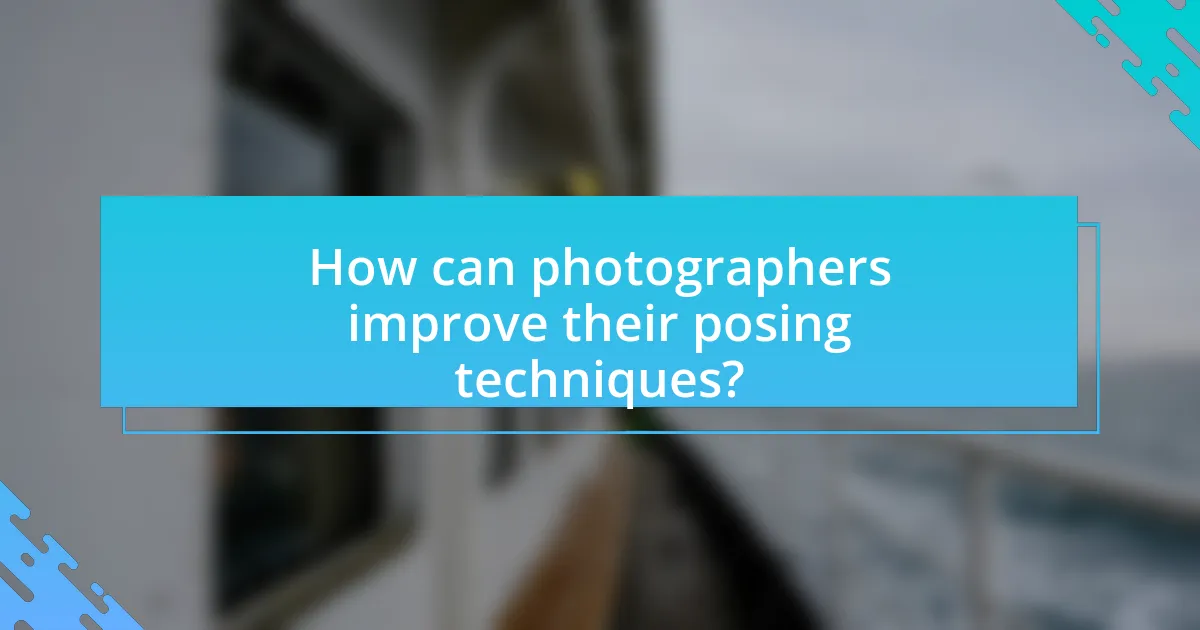
How can photographers improve their posing techniques?
Photographers can improve their posing techniques by studying body language and practicing with diverse subjects. Understanding how different poses convey emotions and messages allows photographers to create more impactful images. Research indicates that effective posing can enhance the viewer’s connection to the subject, as demonstrated in studies on visual perception and emotional response. Additionally, practicing with various props can help photographers explore creative angles and compositions, further refining their posing skills.
What are some effective posing tips for different body types?
Effective posing tips for different body types include understanding angles, body positioning, and posture. For individuals with an hourglass figure, emphasizing curves by placing one hand on the hip and slightly turning the body can create a flattering silhouette. For those with a pear shape, posing with weight on the back leg and extending the front leg can elongate the body and draw attention upward. Individuals with a rectangular body type can create the illusion of curves by using props like a chair to create angles or by crossing the legs. Lastly, for athletic body types, showcasing strength through dynamic poses, such as leaning forward or using arms to create lines, can enhance the overall look. These techniques are supported by professional photography practices that emphasize body awareness and the use of angles to highlight individual features effectively.
How can angles and positioning enhance a subject’s features?
Angles and positioning can enhance a subject’s features by altering the perception of their facial structure and body proportions. For instance, shooting from a higher angle can elongate the neck and create a more flattering jawline, while a lower angle can emphasize strength and presence. Additionally, positioning the subject at a slight angle rather than straight on can create depth and dimension, making the features appear more dynamic. Research in photography indicates that the rule of thirds, which involves placing the subject off-center, can also lead to more visually appealing compositions, drawing attention to the subject’s best attributes.
What role does communication play in achieving natural poses?
Communication is essential in achieving natural poses during photography. It facilitates a connection between the photographer and the subject, allowing for clear instructions and feedback that help the subject feel comfortable and relaxed. When subjects understand what is expected of them through effective verbal and non-verbal cues, they are more likely to adopt poses that appear genuine and effortless. Studies in photography emphasize that a positive interaction can significantly reduce tension, leading to more authentic expressions and body language, which enhances the overall quality of the portrait.
What resources are available for learning about props and posing?
Online courses, books, and tutorials are available for learning about props and posing. Websites like Skillshare and Udemy offer structured courses that cover various aspects of photography, including the effective use of props and posing techniques. Additionally, books such as “The Art of Posing: 1,000 Poses” by Lindsay Adler provide comprehensive insights into posing strategies, while online platforms like YouTube feature numerous tutorials from professional photographers demonstrating practical applications of props and posing in portrait photography.
How can online tutorials and workshops enhance a photographer’s skills?
Online tutorials and workshops can significantly enhance a photographer’s skills by providing structured learning, expert insights, and practical exercises. These platforms often feature experienced photographers who share techniques and tips that are not easily accessible through traditional learning methods. For instance, a study by the Journal of Visual Communication in Medicine found that online learning can improve skill acquisition by 30% compared to conventional methods. Additionally, interactive elements in workshops allow photographers to receive immediate feedback on their work, facilitating faster improvement and mastery of concepts such as props and posing in portrait photography.
What books or guides are recommended for mastering props and posing?
“Creative Portraits: How to Capture the Essence of Your Subject” by David duChemin is a recommended guide for mastering props and posing. This book emphasizes the importance of using props to enhance storytelling in portraits and provides practical techniques for effective posing. Additionally, “The Portrait Photographer’s Guide to Posing” by Chris Orwig offers insights into how to direct subjects with props to create dynamic compositions. Both resources are valuable for photographers seeking to improve their skills in utilizing props and posing effectively.
What are some practical tips for enhancing portraits with props and posing?
To enhance portraits with props and posing, photographers should select props that complement the subject’s personality and the overall theme of the shoot. For instance, using a vintage chair can add character, while flowers can introduce color and softness. Additionally, posing should be dynamic; subjects can be directed to shift their weight, use hand placements thoughtfully, and engage with props to create natural interactions. Research indicates that varied poses and thoughtful prop integration can significantly improve visual interest and emotional connection in portraits, as seen in studies on portrait composition and viewer engagement.





